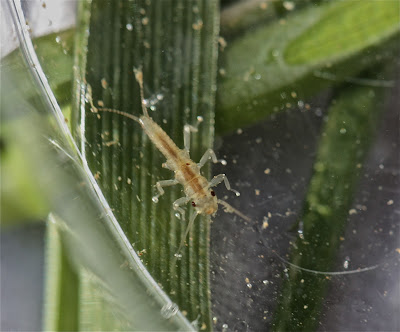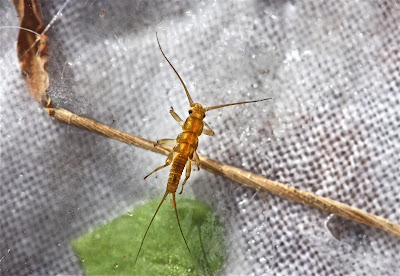Tuesday, December 13, 2011
Already? Lepidostomatids in the Rapidan River
The water in the Rapidan River was running high, fast, and cold this morning, but as always at this time of year, the leaf packs were loaded with insects -- nymphs and larvae. The dominant taxon today, hands down, was the pronggilled mayfly (Leptophlebiidae: genus Paraleptophlebia). But the "shocker" today was the Lepidostomatid case-making caddis, the one in the photo above. It's winter, so I should have expected to see them. Still it seems a little bit early.
Lepidostomatids (the genus is Lepidostoma) are normally found in small, mountain streams, in areas that are heavily forested, where they have good access to the leaves and bark they use to make their cases. The case in the photo above is the one that we normally see: 4-sided, made out of evenly cut pieces of bark, with one piece of bark at the "top" to cover the head of the larva. This is the caddis -- you may recall -- that has two lateral humps on the first abdominal segment, but no dorsal hump -- as in the photo below.
The larva uses these humps to stabilize itself against the sides of its case, then undulates its abdomen, helping to create water flow bringing increased oxygen with it. (Though I doubt that they need to do this a lot in this river, especially at this time of the year.) Below, some more photos of Lepidostomatid larvae that I found this morning (there were quite a few). (In the first photo, note the head of the larva in the smaller case to the left peeking out over the top of the case.)
As I had in my last trip up to this river (11/19), I found 3-4 very small Perlodid stoneflies -- without any question the same species that I found here on that previous trip (have a look at the photos in that entry).
Some pictures.
I have a better idea today about the genus and species of these nymphs than I did just one month ago. These are a species of Isoperla. The mesosternal "Y" ridge was very clear when I looked at them with the microscope, and the lacinia was clearly Isoperla. But the real clincher -- the stripes on the abdomen which are starting to show. Have a look:
The three stripes -- one in the middle, two on the sides -- are used to ID Isoperla Perlodids. Can we go further and take a stab at the species? At the moment I'd go with Isoperla namata (or, Beaty would say, Isoperla nr. namata, since this species is not supposed to show up in our region). Look at the head.
At the front of the head, there is an "M" of sorts taking shape, one with a very thick middle. And, in front of and to the sides of the eyes, we see a pale area that is reaching into the darkly pigmented area in the center part of the head. Compare that to this Isoperla nr. namata that I found in the Rapidan River on March 24th of this year.
We'll have to watch these nymphs as they develop over the winter, but I think this is where these Perlodids are heading.
Here are the other insects of which I took photos today.
1) Pronggilled mayflies -- as I noted, the dominant taxon.
2) Small winter stoneflies (though I saw very few, and there were adults flying around in the air -- i.e. they're hatching).
3) Large winter stoneflies (genus Taeniopteryx). Lots of them. They gave the pronggilleds a run for their money in holding on to the number one place. I got some great photos of one of them.
4) Large winter stoneflies -- genus Taenionema: Taenionema atlanticum. I was surprised to see them again so soon, and I found three of them.
5) And finally, I found another Hexatoma crane fly larva. This is clearly a genus that likes the clean, cold water of remote mountain streams.
Subscribe to:
Post Comments (Atom)



















No comments:
Post a Comment